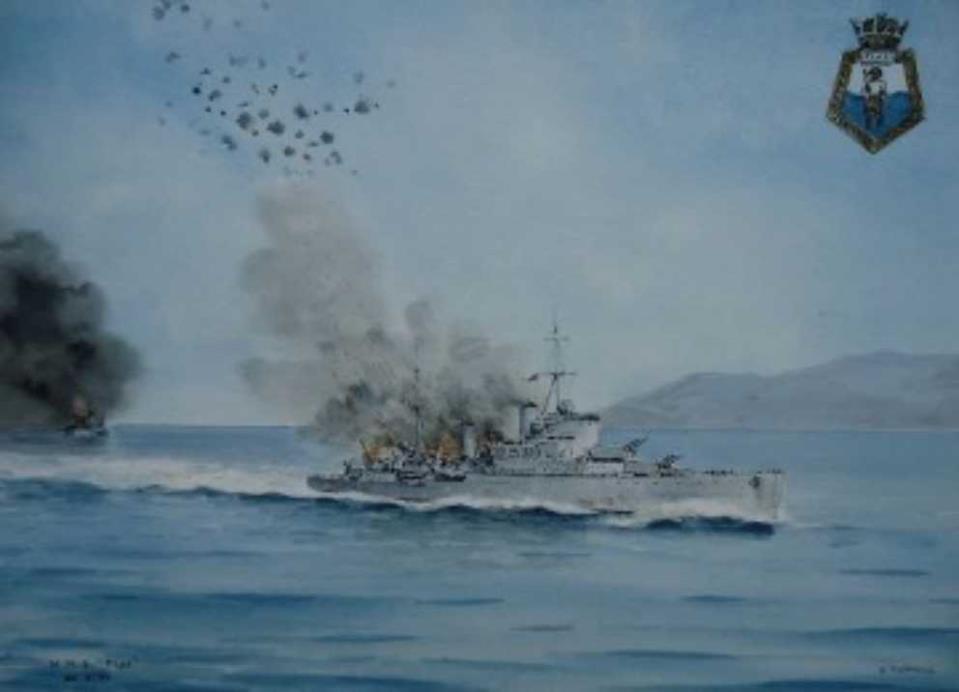Visiting a military cemetery always evokes a certain feeling of sadness, even in the absence of any connection to those buried there.
Despite the uniformity of the gravestones, each one of them represents a different life; a father, husband, son, usually taken far too soon.
But at the same time, what makes those gravestones interesting, is that each one of them normally corresponds to a specific episode that can be traced back.

The Imtarfa Military Cemetery
One such gravestone is that of Commander Philip Somerville RN, located at the Imtarfa Military Cemetery, which recalls his death in Malta at the age of 35 on 4th April 1942.
Born in Castle Townshend, in County Cork, Ireland, Philip came from a distinguished family with a long record of service in either the British Army or the Royal Navy; his father was Vice-Admiral Hugh Gaultier Coghill Somerville CB, DSO.
Philip was commissioned in the Royal Navy in 1927, and had risen to the rank of Lieutenant Commander when in July 1939 he was given command of HMS Kingston, one of the new K-class destroyers.
Over the next few years he would be awarded the Distinguished Service Order twice, and the Distinguished Service Cross also twice.

The gravestone of Cdr. Philip Somerville RN at the Imtarfa Military Cemetery
Shortly after her commissioning in September 1939, HMS Kingston joined the 5th Destroyer Flotilla, Home Fleet, for convoy defence and anti-submarine duties in the North Sea.
On 29th November 1939, together with the destroyers HMS Kashmir and HMS Icarus, she attacked the German submarine U-35 with depth charges off the Shetland Islands, forcing it to be scuttled by her crew.

The crest of HMS Kingston
In May 1940, Kingston was transferred to the Red Sea, and the following month was involved in the sinking of the Italian submarine Evangelista Torricelli, which was forced to the surface and sunk off Perim Island by the guns of Kingston and accompanying destroyers.
In March 1941, Kingston supported landings at Berbera, the capital of British Somaliland, which was recaptured after a six-month Italian occupation.
On 5th April 1941, Kingston found the Italian Leone-class destroyers Pantera and Tigre in the process of being scuttled by their crews, south of Jeddah.
Kingston accelerated the process with her guns and torpedoes.

HMS Kingston was a K-class destroyer of the Royal Navy
Later that month, Kingston was deployed to Alexandria to join the Eastern Mediterranean Fleet. She was involved in the evacuation of Allied troops from mainland Greece, and in the subsequent Battle of Crete, where, as part of Force C, she helped intercept a number of troop transports heading to the island.
Force C became the target of fierce airstrikes, with Kingston suffering splinter damage from three near misses.
On 22nd May, together with HMS Kandahar, she was dispatched to pick up survivors from the destroyer HMS Greyhound, while later that same day the cruisers HMS Gloucester and HMS Fiji were also lost to air attacks.
Once again, Kingston and Kandahar returned to pick up 523 survivors between them.

HMS Fiji under air attack, shortly before her sinking during the Battle of Crete
Kingston returned to Alexandria for repairs in late May 1941.
For the next few months she was mainly tasked with convoy duties to Tobruk and Malta, as well as covering sorties by Malta and Alexandria based cruiser forces against Italian convoys heading to Libya.
On 21st March 1942, she sailed from Alexandria as part of the escort for the ill-fated convoy MW10, destined for Malta.
The following day, the convoy ran into a powerful Regia Marina squadron, resulting in the so-called Second Battle of Sirte.
While turning away following a failed torpedo attack, Kingston was hit amidships by a 15-inch shell from the battleship Littorio, which killed fifteen crewmen and resulted in a flooded boiler and a fire in one of the engines.
Although Kingston temporarily went dead in the water, she was eventually able to continue to Malta for urgent repairs.

The Second Battle of Sirte was a naval engagement between the Royal Navy and the Regia Marina on 22nd March 1942
On 4th April 1942, whilst the destroyer was in dock to repair the damage from the naval encounter, a bomb fell directly at the entrance of the Corradino Tunnel, where part of her crew had taken shelter.
Fourteen crewmen were killed by the blast, including Commander Somerville.
Kingston was again attacked by German aircraft on the following day, resulting in further damage from a near miss, while on 8th April, another bomb struck the forward section.
Although it failed to explode, it passed all the way through the ship’s bottom, forcing Kingston into dry dock repairs. On 11th April 1942, while she was in No. 4 dock, Kingston was hit again, causing her to roll over on her side and sink in the dock.
The ship was declared a constructive total loss.

HMS Kingston was declared a constructive total loss after her latest bombing on 11th April 1942 whilst undergoing repairs in No. 4 dock
It was not until January 1943 that the dock was dried-out, and the hulk of HMS Kingston was eventually towed to St. Paul’s Bay and scuttled as a blockship between Selmun and St. Paul's Island, while some years after the war, the remains were scrapped in situ.
Today, only a few pieces of metal still remain.
As for the men, twenty-one members of HMS Kingston’s crew are buried in Malta, either at the Imtarfa Military Cemetery or at the Capuccini Naval Cemetery.
This figure includes some of those who were killed at the Second Battle of Sirte, as well as the fourteen who died as a result of enemy bombing whilst in Malta.
Commander Philip Somerville DSO & Bar, DSC & Bar, RN is buried in Plot 1 Row 1C Grave 3 at the Imtarfa Military Cemetery.
Matthew Camilleri is Tours Manager at Colour My Travel.
www.colourmytravel.com